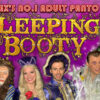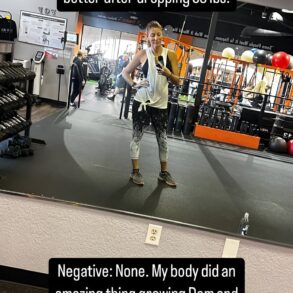
Seems like everyone around me these days is shrinking, disappearing even, before our very eyes. Yes, most of them are in their 70’s are 80’s even, most of them women, but I have come to pay especially close attention to my elders for tips (and, truth be told, more often warnings) of where I (where we) might need to be in my early 60’s to be or not to be where they are decades later. Should we all live that long. For better or for worse.
Yes, think nutrition (proteins, fats, minerals). Yes, think stomach acid sufficiency (rule out achlorhydria, as they call it in the biz, which btw is often the result of chronic “fight or flight” state of mind…). Rule out dysbiosis and/or other potential causes of chronic, low-grade inflammation. But #1 for me? I am blaming (chronically elevated) cortisol. I am blaming the sea of stressors we’ve all been bathed in these past, geez, EIGHT (??!!) years now. With more, much more?, to come. How to best protect & insulate ourselves?
(As aside: Looking back to the early days of AIDS, I now think that the dreaded “AZT butt” was very likely not so much the effect of AZT itself, although muscle wasting was a documented side effect of the thymidine analogue drugs, AZT and d4T, but of the acute stress of finding oneself in a situation where taking AZT was indicated. I wonder if anyone else has studied that period. It would be really interesting to see. Cal Cohen, Paul Bellman, Donald Kotler, are you out there??)
Not only can chronically elevated cortisol lead to unstable blood sugar & leach your bones, but it also actually shrinks your hippocampus— that kind of super important part of the brain tasked with learning & memory. (Actually also tasked with moving short-term memories to long-term memory. Sound familiar?) And its ramped up production seems to squeeze out production of all the other necessary hormones: pregnenolone (often called “the hormone of memory”), Dhea (super knowledgeable if not legendary nutritional medicine know-it-all Alan Gaby (MD) is said to have called it “qi incarnate”), testosterone, estrogen.
I don’t know off hand who the big thinkers and planners are in this arena, but I for one expect to see a, let’s call it, sorry I know tsunami is way overused; I can still hear Marty Markowitz’s characteristically melodramatic admonition at ADARC centuries ago, a “tsunami of sequelae” in ten years or so (he was warning about the coming meth epidemic in MSM communities, and in this instance he was spot on), from the huge hit everyone’s hormones have taken over these past years. Put it quite simply, stress kills. But worse than killing it incapacitates. It erodes and erases. Don’t be another statistic if you can help it!
For my self-preservation, however lame or symbolic, I have just canceled (nearly) all of my news subscriptions. Even wiped the apps from my phone. I was never much of a TV news watcher, but I’m even saying goodbye to PBS heartthrob Nick Schifrin as well as Amna, Geoff, John, Ian Bremmer and perhaps my erstwhile global touchstone, who conveniently airs as the last light of late autumn falls, Sumi Somaskanda. So long too to my guilty end-of-week wrap-up analyses of Jeffrey Goldberg, Chuck Todd, of Brooks & Capehart (fast forward to 8:08 for his hilarious Whoopi Goldberg aka Oda Mae Brown-DJT warning mashup). Even the otherwise soothing bordering on soporific Bill Kristol. Yes, I am sticking my head in the sand until December 2024. Shoot me.
No Facebook messenger. No IG. No Tiktok. (Never really my demographic.) None of that.
Notifications on my phone, other than calls and WhatsApp, turned off.
And I am going to do my best to re-establish a twice daily meditation routine: 20 minutes at a pop. Nothing fancy. I was super fortunate to be invited by one of my gym yoga instructors (he called himself “aka Light“ at the time and did the Saturday morning ”power yoga” class at Crunch on Sunset & Crescent Heights Blvd. Sarah Isenberg did the Sunday class. The perfect 90-minute Sunday yoga class. I didn’t have (or want) a car, so I took the #217 bus home to Hollywood. (Oh dear, what is she up to now? Is this her? Seems post-Covid every formerly in-person-only person’s got a gig going now…) Together they were kind of the Yin and Yang of yoga class energies, and I miss and will always be so, so grateful for their dedication and inspiration.) to his WeHo pad for a free intro to Vedic meditation (formerly known as TM) sometime in 2006 or 2007 after I’d trekked out to La La Land to work with the late Charles Farthing at AHF. At first it was a challenge to turn off the monkeys in my mind. But he gave us each a one word sort of mantra to focus on, and soon enough the monkeys were chattering less and less. And finally (mostly) gone.
These are the online, group and “intro to” meditation resources I know of or have found in NYC/Manhattan:
- Integral Yoga, 227 West 13th St, free, drop-in meditation sessions, pretty much every day @ noon
- While not meditation, Iyengar Yoga NY, just next door/up stairs, offers free (a bit strange & very long) yoga classes (with intro chanting) for HIV+ (11 a.m. Fridays, in-person only) and POC (12:30 Saturdays, in-person or online)
- If you’re a subway advert reader, you might remember the School of Practical Philosphy. They advertise $10 intro meditation classes at both UES (East 79th St) and Tribeca/Duane Street (Laughing Man Cafe) locations.
- I cannot vouch for this one, but Vedic meditation intro & training offered at the New York Meditation Center (122 W 26th St #701)
- Finally, I pass Kadampa Meditation Center every week or two as I trek across West 24th St (almost @ 8th Ave) between Sullivan Street Bakery and Madison Square Park. Appears to be Buddhist based. Intriguing and in Chelsea.
Covid has not been kind to yoga studios (or yoga teachers) and, it appears, meditation centers. Nearly half the places on this list at Zencare.co have since been shuttered. It’s a Manhattan centric list, and I for one find sleeping in Manhattan and peace of mind kind of oxymoronic, so will get working asap on options in the other boroughs (I loved Shala Center on Bway/11th before it closed during Covid and have been wanting to visit their new-ish Fort Greene digs. I see they too offer free meditation sessions, online only, at 8:00 a.m. on Saturdays.) and nearby NJ. Here’s what was left after combing through the ZenCare list:
East Village (E 3rd)
Tuesdays 8:15-8:45 a.m.
Union Sq (E 17th)
Hope Martin (she offers private & group training)
Alexander Technique based
I see she is offering a one-day workshop Jan 6, 2024 for $125
Paula Tursi (Union Sq @ E 16)
formerly of Reflections studio in Kips Bay)
her Kips Bay refuge has, post-Covid, apparently morphed into Paula Tursi.com
Midtown (W 36th)
Four free public sessions each Friday: 12:15, 1, 5:45, 7pm
What does any of this have to do with cortisol and shrinking? It all seems to come around to hormone preservation. Sure, you can shoot up with T or rub yourself with different gels and creams. But after kind of carefully watching the Chrissy Snow actress’ hormone & personal health journey over the years, I still kind of take hormones seriously.
One of the more bombastically self-regarding heads of the hormone faculty at the IFM, Joel Evans, likes to point out that, with estradiol especially, is so potent that it is measured in PICOGRAMS per mL, whereas the other sex hormones are measured in nanograms or even micograms (per dL or mL). So if you’re going the exogenous supplementation route, you kind need to make sure you know what you’re doing. At least that’s my take. And to monitor breakdown/elimination, especially the estrogen metabolites.
The world of hormones is an Alice In Wonderland rabbit hole all of itself. Endlessly fascinating, but you could spend the better part of a year immersed in all of it. So I’m going with resistance training (induces exogenous androgen production) and meditation (helps to keep the cortisol surges at bay) to help to restore and preserve my hormones for now.
For the past half dozen, god no, nearly 10 years now, I have worked with the Dale Bredesen team on cognitive health and neurodegeneration, the prevention slash reversal thereof. It was really the first time I was introduced to the shocking contrast of optimal hormone levels and actual hormone levels (not to mention excess estrogen levels in many middle-aged men, sometimes only detected though after looking at the lesser known estrogens, particularly E1 or estrone, but also E3/estriol) in real people. Here are the ranges he and his team use, though note that even hormones like Dhea and testosterone fluctuate somewhat throughout the day. Some argue that Dhea and cortisol best measured in saliva, but these docs use & seem to prefer venous blood. And certainly it’s the most common practice for now.
|
Cortisol (early morning) micrograms per dL |
|
|---|---|
| Target Range (Venous Blood), Post-Menopausal Women |
10-18 (Strongly affected by timing of draw) |
| Target Range, Venous Blood, (Middle Age+) Men |
10-18 (Strongly affected by timing of draw) |
|
Dhea (Dhea-S in blood) micrograms per dL |
|
|---|---|
| Target Range (Venous Blood), Post-Menopausal Women |
(Disagreement here) Dr. Bredesen wants 350-430 Dr. Hathaway says “minimum 100” |
| Target Range, Venous Blood, (Middle Age+) Men | 150-500 |
|
Estradiol (E2) picograms per mL |
|
|---|---|
| Target Range (Venous Blood), Post-Menopausal Women |
50-250 But “minimum of 80 to prevent bone loss” |
| Target Range, Venous Blood, (Middle Age+) Men | < 39 |
|
Progesterone (P4) nanograms per mL |
|
|---|---|
| Target Range (Venous Blood), Post-Menopausal Women |
1-20 But must be balanced with E2, roughly 1/8 to 1/6 of E2 levels, or minimum 1:10 ratio |
| Target Range, Venous Blood, (Middle Age+) Men | < 1.4 |
|
Testosterone nanograms per dL |
|
|---|---|
| Target Range (Venous Blood), Post-Menopausal Women |
30-70 Some say minimum of 40 |
| Target Range, Venous Blood, (Middle Age+) Men | 50-1,000 |
|
Free Testosterone picograms per mL |
|
|---|---|
| Target Range (Venous Blood), Post-Menopausal Women |
0.02-0.5 |
| Target Range, Venous Blood, (Middle Age+) Men | 6.5-15 |
|
Pregnenolone nanograms per dL |
|
|---|---|
| Target Range (Venous Blood), Post-Menopausal Women |
100-250 Earlier draft was 50-200, but folks now seem to agree on minimum value of 90-100 |
| Target Range, Venous Blood, (Middle Age+) Men | 100-250 |
|
Vitamin D nanograms per mL |
|
|---|---|
| Target Range (Venous Blood), Post-Menopausal Women |
50-80 |
| Target Range, Venous Blood, (Middle Age+) Men | 50-80 |
Heavy-set folks, as they said back on the prairie, might actually have an issue with excess hormones, especially estradiol. Especially in men with paunches. That’s another topic entirely of itself and will cover separately. I am still kind of in the process of trying to figure out the role— either proven or theoretical— that excess estrogen plays in the risk of prostate cancer, even BPH, in men. “Necessary but not sufficient?” “Sufficient but not necessary?” I am now tripping into a Rumsfeldian word play, so will stop for now. It seems to come down to whether the alpha or beta estrogen receptors are being stimulated. More later.
So the shrinking women in my life. We have measured hormones on some of them and, unsurprisingly, almost without exception their hormone levels (we have measured in blood, in saliva, and in spot urine at various time points and compared, partly out of curiosity since there are strong opinions on the validity of even measuring in blood) are below the lower limit of the “normal” and “recommended” postmenopausal ranges.
The younger of the group, 64, went to her GP/gyn and expressed her concerns: bone, brain, skin, cardiovascular health, anxiety/sleep as she ages, and her GP even her gyn kind of looked at her quizzically. Not so gently taunted her in the clinic notes we accessed online later. Not a great sign. The progesterone he eventually agreed to was medroxy-progesterone (aka Provera) and not the bio-identical* she had asked for. (Link to great textbook) And because he had the estradiol:progesterone ratio off (well, had no idea one needed to consider such a thing, truth be told), or had the poorly absorbed medroxy progesterone, she began to bleed within a week or two. (He had also rx’d her oral estradiol, conjugated equine estrogen (yes, as in horse urine) which is not recommended by more knowledgeable folks in this area.) Since they don’t appear to understand these things, they pressured and pressured her to go for a uterine cancer scan. Eventually she gave up on the whole thing. This seems to be the kind of “expertise” one gets in this increasingly corporatized, insurance-based medical system most Americans are doomed to rely on. She is now working with an IFM trained MD not only versed in but teacher of hormone health in aging. But at $600 an hour, private pay. It’s the world we live in, unfortunately. And more and more each day as hospitals and medical centers continue to merge and consolidate. Will report back nevertheless.
Another one who’s shrinking is mostly worried about her bones (her MD gave her calcium & vitamin D— a relic from his medical school training, no doubt; I hit the ceiling) and, more recently, what the profession would call sarcopenia but basically struggling, struggling, struggling to maintain her weight, to not lose any more lean body mass.
That’s my plight as well. I still think resistance training, three or four 30-minute sessions a week (but even the New York Times 7-Minute Workout at home would be better than nothing, as its routine is heavy on thigh & butt muscles) and, however/whenever possible, programmed “quiet mind” moments aka meditation, are the obvious go-to’s here. Some folks would suggest a modest dose of Dhea (5-10 mg for women, 10-25 mg for men, are the customary doses). Yet others would add on pregnenolone, anywhere from 10-20 mg to 30 or 50 mg. Both of these the body can convert into the sex hormones, with the exception of Dhea, which can only be converted into testosterone and estrogen. But beware: in overweight or out of shape men in particular, Dhea is said to be preferentially converted into E1 or estrone, which is both (systemically) inflammatory and has a binding preference for the alpha estrogen receptors of the prostate. Again, more on that in a later post.
But hormones, even the estrogens and progesterone, are also a men’s thing. Again, think Goldilocks here: not too cold, not too hot. Since my world is mostly folks in their 50’s and beyond looking to get everything possible in place so that they can live the next forty or fifty years with pretty much all the energy, faculties, good humor and flexibility they enjoy now, we are taught to monitor ALL the sex & adrenal hormones (except maybe E3): E2, E1, P4, T, DHEA, pregnenolone— including SHBG. In all states but New York State, folks can do this on their own (OwnYourLabs is our current darling), but of course the ideal situation would be to work with someone knowledgeable (but not crazy or not up to date) in this area. Yes, there are tons and tons of online resources; the trick is figuring out who knows what s/he’s talking about and who is a little (or alot) off. And beware what I would call the “Chrissy Snow trap:” looking for quick fixes/shortcuts & thinking that more is always & necessarily better.
*Regardless of what you might read on the NAMS website, to pick just one example, bio-identical and pharmaceutical hormones are not equivalent. (Just for fun, pull up NAMS’s latest 990 to see where the organization gets its funding. Or its “Corporate Liaison Council.” You guessed it. Big Pharma. I know because when I was briefly back in Ohio (when my father was very ill) I interviewed to write for them at their Beachwood/Pepper Pike HQ. They are even all-in, it appears, on the use of rx drugs to prevent osteoporosis!) “Bioidentical hormones have a chemical structure identical to human hormones but are chemically synthesized [most often from plant steroids derived from wild yam or soy], such as progesterone, estriol, and estradiol. Nonbioidentical hormones are not structurally identical to human hormones and may either be chemically synthesized, such as MPA, or derived from a nonhuman source, such as CEE,” (Holtorf, 2009) which is made of pregnant mare’s urine. I’m not making this up!
Mike Barr, a longtime Poz Contributing Editor and founding member of and scribe for the Treatment Action Group (TAG), is a functional medicine practitioner and herbalist in NYC. Reach out to him here. Or sign up for his curated (and generously discounted) professional grade supplement store here.
This post was originally published on this site be sure to check out more of their content.









